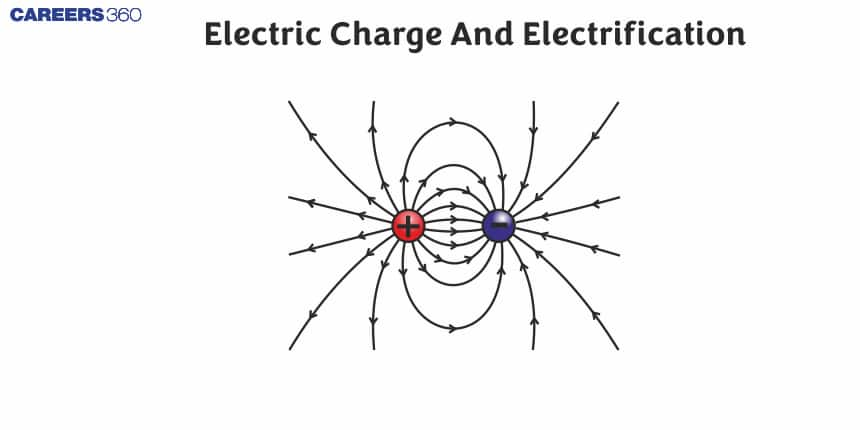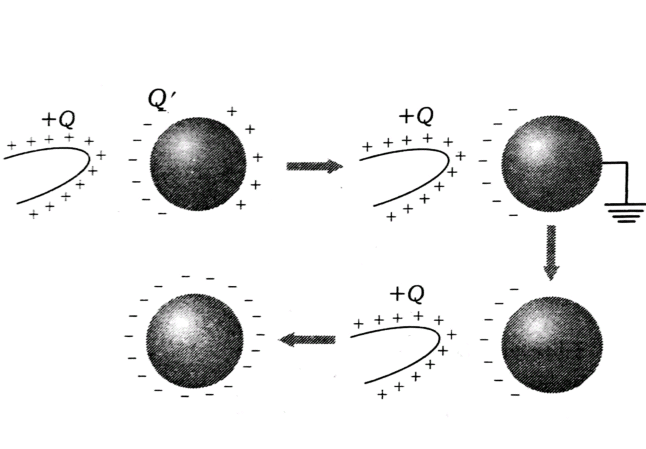Electric Charge And Electrification
An electromagnetic field is like a giant rubber sheet where electric charges can be compared to small balls. There are positive charges (protons), negative charges (electrons) and neutral charges (neutrons) in an atom. And all objects themselves consist of positively and negatively charged particles while they tend to be neutral overall because the quantities of positive and negative charges in them are equal. However, due to these charges’ properties, some of them may attract or repel other particles or objects.
JEE Main/NEET 2027: Physics Important Formulas for Class 10
NEET 2025: Mock Test Series | Syllabus | High Scoring Topics | PYQs
JEE Main: Study Materials | High Scoring Topics | Preparation Guide
JEE Main: Syllabus | Sample Papers | Mock Tests | PYQs
- What are the Conductors and insulators?
- Methods of charging
- Solved Examples Based on Electric Charge And Electrification
- Summary

Based on two different contexts, electrification and electric charge are the pillars upon which electricity and magnetism understanding is anchored; this forms an integral part of NEET and JEE Main exams. Electric charge is defined as one of the matter’s primary attributes; it significantly influences many other physical events and developed technologies. Electrification refers to gaining or losing electric charges while discussing materials’ response to electric fields; these include such ideas as electric potential and force due to static charge.
What are the Conductors and insulators?
When a plastic rod is rubbed with cat fur and is connected with a neutral pith ball via a copper wire, it is observed that the pith ball gets negatively charged. But when a plastic rod rubbed with cat fur is connected with a neutral pith ball via a rubber the pith ball remains neutral. That is copper allows passage of charge and rubber does not. The materials which allow passage of electricity are known as conductors and the materials which do not allow the passage of electricity are known as insulators.
Methods of charging
There are three methods
By Friction: When two bodies rub together both positive and negative charges in equal amounts appear simultaneously due to the transfer of electrons. When a glass rod is rubbed with a silk cloth, the electrons are transferred from the glass rod to the silk. The glass rod becomes positively charged and the silk rod becomes negatively charged.
By induction: When a charged body is brought near an uncharged body, one side of the neutral body becomes oppositely charged while the other side has the same charge. For example, when a positively charged glass rod is brought near a paper the paper gets attracted, this is because of the rod attracts the electrons of paper towards it so that the edge of the paper near the rod becomes negatively charged and the other end becomes positively charged due to deficiency of electrons.
By conduction: When two conductors are brought in contact, the charges will spread over both the conductors. For example, when a negatively charged plastic rod is brought in contact with a neutral pith ball some of the electrons of the rod are transferred to the pith ball and the pith ball also becomes negatively charged.
Recommended Topic Video
Solved Examples Based on Electric Charge And Electrification
Example 1: Two equal spheres are identically charged with q units of electricity separately. When they are placed at a distance 3R from centre-to-centre where R is the radius of either sphere the force of repulsion between them is
1)
2)
3)
4) None of these
Solution:
By electrostatic induction
When a charged body is brought near an uncharged body, one side of the neutral body becomes oppositely charged while the other becomes the same charged.
wherein

Generally, students give the answer

Example 2: A table tennis ball which has been covered with conducting paint is suspended by a silk thread so that it hangs between two metal plates. One plate is earthed. When the other plate is connected to a high-voltage generator, the ball
1) Is attracted to the high-voltage plate and stays there
2) Hangs without moving
3) Swings backwards and forward hitting each plate in turn
4) None of these
Solution:
By electrostatic induction
When a charged body is brought near an uncharged body, one side of the neutral body becomes oppositely charged while the other becomes the same charged.
wherein

The table tennis ball when slightly displaced say towards the positive plate gets attracted towards the positive plate due to induced negative charge on its near surface.

The ball touches the positive plate and itself gets positively charged by the process of conduction from the plate connected to a high-voltage generator. On getting positively charged it is repelled by the positive plate and therefore the ball touches the other plate (earthed), which has a negative charge due to induction. On touching this plate, the positive charge of the ball gets neutralized and in turn the ball shares the negative charge of the earthed plate and is again repelled from this plate also, and this process is repeated again and again.
Here it should be understood that since the positive plate is connected to a high voltage generator, its potential and hence its charge will always remain the same, as soon as this plate gives some of its charge to ball, excess charge flows from the generator to the plate, and an equal negative charge is always induced on the other plate.
Example 3: Electric charges of
1) 0.9 N
2) 1.8 N
3) 2.7 N
4) 3.6 N
Solution:
By conduction
When two conductors are brought into contact.
wherein
i.e. The charge will spread over both the conductors.

The net force on C
Hence, the answer is option (2).
Example 4: Which of the following are methods of charging?
1) Charging by friction
2) Charging by induction
3) Charging by conduction
4) All of the above
Solution:
Methods of charging
By Friction: When two bodies rub together both positive and negative charges in equal amounts appear simultaneously due to the transfer of electrons. When a glass rod is rubbed with a silk cloth, the electrons are transferred from the glass rod to the silk. The glass rod becomes positively charged and the silk rod becomes negatively charged.
By induction: When a charged body is brought near an uncharged body, one side of the neutral body becomes oppositely charged while the other side has the same charge. For example, when a positively charged glass rod is brought near a paper the paper gets attracted, this is because the rod attracts the electrons of paper towards it so that the edge of the paper near the rod becomes negatively charged and the other end becomes positively charged due to deficiency of electrons.
By conduction: When two conductors are brought in contact, the charges will spread over both the conductors. For example, when a negatively charged plastic rod is brought in contact with a neutral pith ball some of the electrons of the rod are transferred to the pith ball, and the pith ball also becomes negatively charged.
Hence, the answer is the option (4).
Example 5: Two identical balls having like charges and placed at a certain distance apart repel each other with a certain force. They are brought in contact and then moved apart to a distance equal to half their initial separation. The force of repulsion between them increases 4.5 times in comparison with the initial value. The ratio of the initial charges of the balls is
1) 2
2) 3
3) 4
4) 6
Solution:
By conduction
When two conductors are brought into contact.
wherein
i.e. The charge will spread over both the conductors.
Suppose the balls have charges Q1 and Q2 respectively.

It is given that
On solving it gives
Hence, the answer is option (1).
Summary
The electric charge is a significant element of materials that forces them to interact with magnetic fields. There are two forms of electric charge-positive and negative; materials with similar types of charges repel each other If the charges differ, partners are pulled towards each other. Electrification involves the process of rubbing some material; this may remove or increase its charge when it gets back. This can occur through various methods such as friction, conduction, and induction.
Also Read
17 Nov'24 10:27 AM
17 Nov'24 10:09 AM
17 Nov'24 10:02 AM
26 Sep'24 11:50 AM
26 Sep'24 11:48 AM
26 Sep'24 11:26 AM
25 Sep'24 06:31 PM
25 Sep'24 06:24 PM
25 Sep'24 05:32 PM
25 Sep'24 01:35 PM